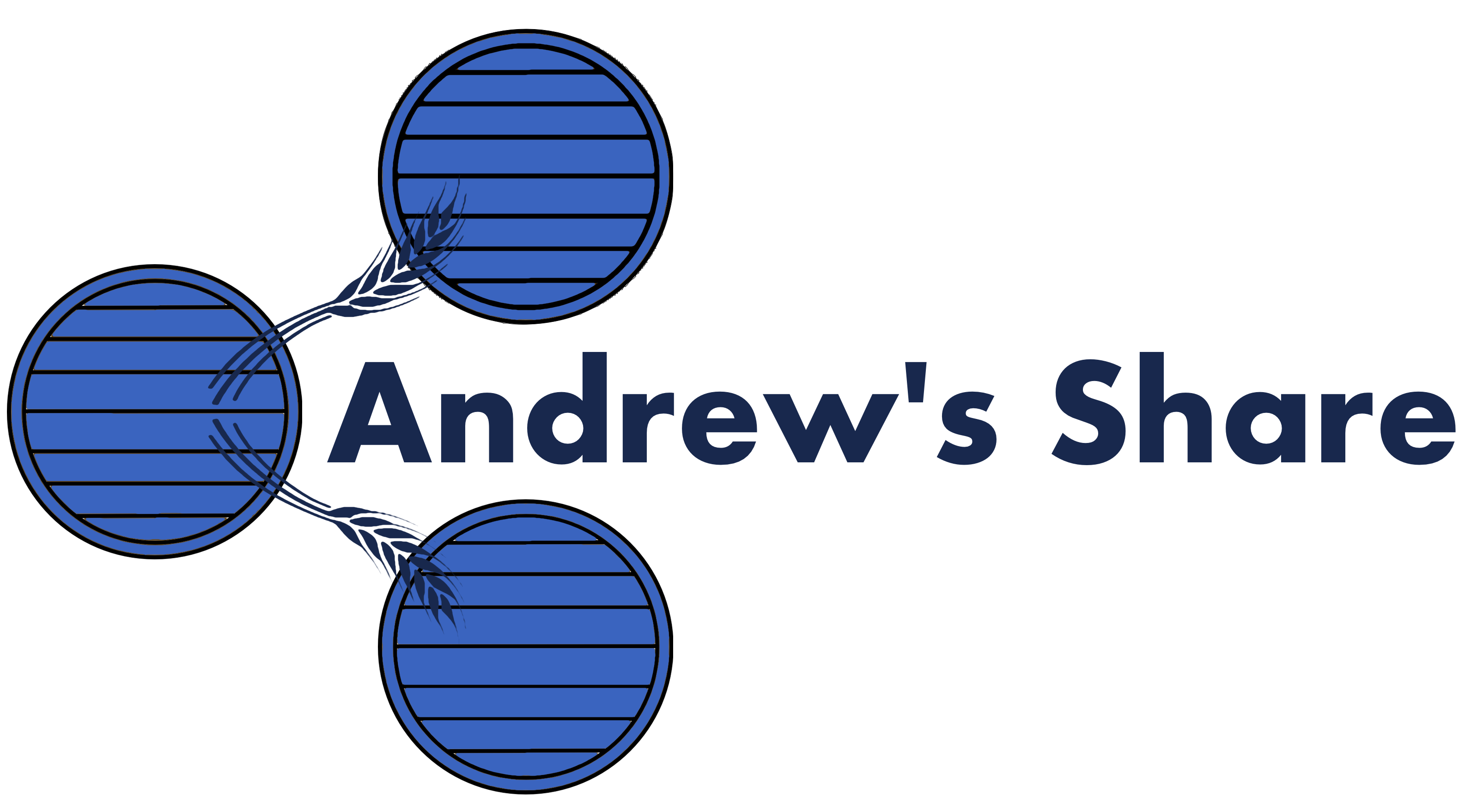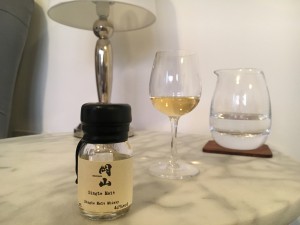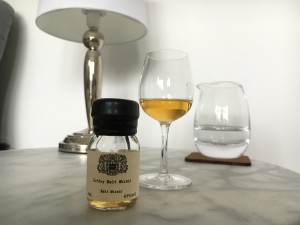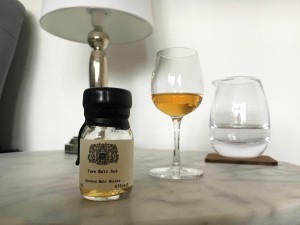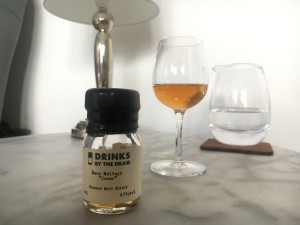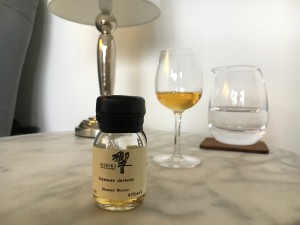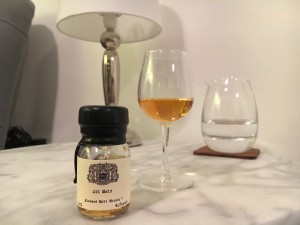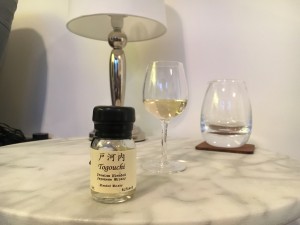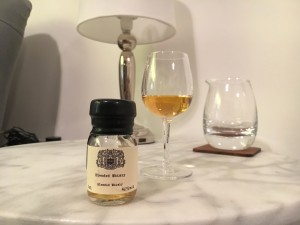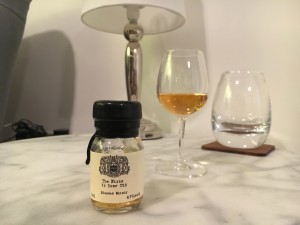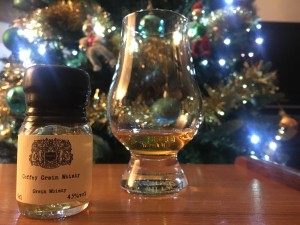Jump straight to the latest update
Another year has passed and once again it’s time to put up trees, decorate our living rooms with anything shiny or sparkly, and of course the most important tradition in my household: sample a new whisky for each day of advent! Luckily the good people at Drinks by the Dram have us covered as always with their ever-growing diverse range of spirit-based advent calendars.
Japanese whisky is a category into which I have dipped my toes although it has not yet featured on this blog. With rising popularity and huge pressure on existing stock it is becoming more and more difficult to find any Japanese whisky at a reasonable price in the UK. Rather handily Drinks by the Dram produce a Japanese Whisky Advent Calendar – what better way to familiarise with the landscape than with 24 30ml samples encompassing single malts, single grains and blended whisky from across Japan?
This post tracks my journey across the Land of The Rising Sun and will (hopefully) be updated daily with my thoughts on each whisky.
Advent begins with a single malt from Miyashita, a distillery which is relatively unknown in whisky circles. Based in the Okayama Prefecture (hence the name of today’s dram), Miyashita has been around for quite a while – indeed this whisky was released to celebrate its 100th anniversary – however it is traditionally a sake brewer, having expanded into whisky with the opening of its distillery in 2011.
Although no age is stated on the bottle we can derive it will be 3-4 years old: the whisky is said to contain spirit from the first year of operation of the distillery and was released in 2015 – the firm’s centenary year. Produced from a mix of German and locally grown barley, the whisky has seen a full maturation in ex-brandy barrels.
Nose: Starts off somewhat odd with vegetal notes reminiscent of balsamic onions. Once this settles there is a robust malty cereal character, salted porridge or the aroma of a tun room in operation! In the background there is a floral aspect of orange blossom.
Taste: Much more settled than the nose, a pleasantly creamy mouthfeel delivers soft stone fruit balanced with malt sweetness. The brandy casks make their influence felt through a sweet floral honey note. A touch of menthol can be detected towards the finish.
Finish: Sweet honey is joined by marzipan on a finish that is reasonably long for a young whisky.
There is potential here for some very tasty whisky, however the nose has some fairly prominent flaws that need sorting out which places the £140 price tag outside of the good value range.
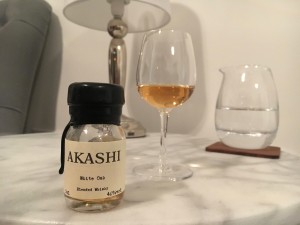 2nd: White Oak Akashi Blended Whisky
2nd: White Oak Akashi Blended Whisky
Today we travel east to the city of Akashi in the neighbouring Hyōgo Prefecture to sample whisky from White Oak distillery. White Oak is owned by Eigashima Shuzo, a family run company who have whisky-making experience dating back to 1919 when they pioneered making whisky in the Scottish style with Japanese influence (the same underground water source used in their sake production was used in the whisky distillery). Fast forward to 1984 the equipment was transferred to the new White Oak distillery. Located by the sea, Akashi enjoys a fairly mild climate which should in theory provide favourable maturation conditions.
Today’s whisky is a no-age-statement blend which serves as White Oak’s entry-level offering. As is common in some global whisky markets the locally sold Akashi is actually a blend of malt and molasses spirit (and hence would not be considered whisky in many jurisdictions), but luckily we have the export version which is a classic blend of malt and grain whiskies. Unlike in Scotland, Japanese whisky companies do not offer their malts and grains to other producers for blending so Japanese blended whisky is typically all produced by a single institution. However unless you are a big player with the facility to produce both malt and grain spirit the only option is to import grain whisky – as Eigashima Shuzo have done here.
The malt in the blend has been aged in American oak ex-bourbon casks before a finishing period in ex-sherry casks. At a ratio of around 40% malt to 60% grain, this is a reasonably malt-heavy blend.
Nose: A fairly fruity nose brings orange blossom and white grape. On the sweet side there is some creamy fudge, while lingering in the background is a drying mineral note.
Taste: Consistent with the nose there are gentle sweet fruit notes. On the mid palate there is some baking spice with nutmeg and cloves, giving a rye-like feel to the dram.
Finish: The rye-like character builds on the finish bringing some heat with white pepper.
A straightforward and pleasant blended whisky that makes a good sipper. At around £30 (albeit for a 50cl bottle) this is pretty decent value.
 3rd: Hakushu Distiller’s Reserve
3rd: Hakushu Distiller’s Reserve
Day 3 of Advent sees our first encounter with one of the giants of Japanese whisky in the shape of the Suntory-owned Hakushu distillery. If truth be told, describing Suntory as a giant of Japanese whisky is probably doing them a disservice today – the Beam-Suntory group is one of the world’s largest spirits company comprising a diverse portfolio of Scotch, American, Irish and Canadian whisk(e)y as well as the Japanese brands, not to mention the wide array of other spirits under their umbrella.
Hakushu is Suntory’s second malt distillery in Japan (the first being Yamazaki). Built in 1973, the distillery is in the most remarkable location in the Yamanashi Prefecture, situated on the slopes of Mount Kaikomagatake in the Japanese Alps at an altitude of around 700 metres. This location was originally chosen primarily for its water source as part of Suntory’s quest to further increase the variety of styles of whisky available under their brands.
Today’s whisky is the Distiller’s Reserve, the entry-level no-age-statement malt whisky serving as an appropriate introduction to the distillery character. This whisky is blended from three primary constituents: a young talent lightly-peated whisky aged (typically less than 10 years) in ex-bourbon casks, an old whisky that has spent more than 18 years in American white oak (whose previous contents are not disclosed although presumably bourbon) and a more heavily-peated 12 year old whisky.
Nose: Very fresh, lots of herbal character with fresh mint taking the lead alongside cut grass, marjoram and other green notes. Behind this there is light wood spice and a little char: toasted vanilla. On the fruity side is green apple with skins on.
Taste: The palate brings more sweet fruit than the nose with dried papaya and peach which nicely balances the light herbs and wood spice. Towards the back of the palate the herbal notes dominate with a little citrus lightness.
Finish: Warm spice mingles with dried herbs on a background of distant char smoke.
A very pleasant whisky which although quite straightforward is delivered flawlessly – impressive stuff for around £55!
From one giant to another, today we meet Japan’s second largest distiller and the other big established player in the Japanese whisky world. Nikka was founded by the legendary godfather of Japanese whisky, Masataka Taketsuru. Taketsuru famously studied chemistry and embarked on distilling apprenticeships in Scotland before he and his Scottish wife moved to Japan. After a period working for (what later became known as) Suntory he left to start his own distilling company, initially building Yoichi distillery in 1934.
Fast forward to the present and Nikka own Yoichi, Miyagikyo distillery (where both malt and grain whisky is produced) and a handful of warehouse locations and bottling plants. As is the norm for Japanese whisky companies this diversity allows Nikka to bottle an array of single malts, single grains and blended whiskies.
Today’s whisky is From The Barrel, a no-age-statement blend comprising malt whisky from Yoichi and both malt and grain whisky from Miyagikyo. There does not appear to be any concrete information on initial cask selection, but what gives this whisky its name is a 3-6 month period where the blended whisky is married in first fill ex-bourbon casks. This technique is quite unusual for blended whisky, where a short marriage in stainless steel vats is more the norm. It is also unusual to see a blended whisky bottled at such a high strength: 51.4% ABV. Lots to pique the curiosity of the whisky enthusiast!
Nose: Light red fruit and orange peel sprinkled with Demerara sugar, then a wave of warm vanilla. Given some time the nose becomes quite lively with malt, fresh wood shavings and a touch of char. Eventually the fruity notes become a little floral. The nose opens up nicely with a drop of water allowing the vanilla and wood spice to shine.
Taste: Initially quite malty. There is some honey and toffee sweetness with plenty of vanilla and warm winter spice, peaches and cream. A very pleasant mouth-coating palate.
Finish: A long finish of toffee with light baking spice.
A lively blend which pulls no punches, and although it’s a 50cl bottle this is still great value at under £40.
We continue advent with another dram from The Nikka Whisky Distilling Company. In a blind tasting you would never identify yesterday and today’s whisky as from the same distiller, and understandably so as they are fundamentally different spirits. This serves as a useful example of one of the core differences between the whisky industries in Japan and Scotland: there is no sharing spirit between distillers and blenders in Japan – one company will produce each style of spirit required for their portfolio. This is quite unlike Scotland where a distiller will typically produce a single particular style of whisky and blenders are often separate companies who will buy casks from a whole host of distilleries. One exception to this rule in Scotland is Loch Lomond distillery which is very much in the Japanese style with an array of pot, column and hybrid stills to produce multiple styles of whisky sold both individually and to make up the group’s blends.
Today’s dram gets its name from the Coffey still (also known as a column, continuous or patent still) used in its production. Named after the Irishman Aeneas Coffey who finalised and patented the design, this type of still is very different from the copper pot stills one may have come across while visiting a typical malt distillery. Instead, two long columns work as a pair with the first column (the analyser) containing porous plates which serve as a series of pot stills, vapourising and condensing the liquid at successively lower temperatures moving up the column. The second (rectifying) column further separates the lighter compounds from the heavier, resulting in a spirit much lighter and higher in alcohol content than that from a traditional pot still.
While most column-distilled whisky is from a grain mashbill (typically corn or wheat), today’s whisky is distilled from 100% malt barley making it a very unusual (although not completely unique) style of whisky. Produced at Nikka’s multi-functioning Miyagikyo distillery, this whisky offers no information on age nor maturation and is bottled at a healthy 45% ABV.
Nose: A buttery sweetness with plenty of spice: vanilla, cinnamon, ginger and more! There is some tangerine peel on the zesty side, and far in the background is a hint of liquorice. A drop of water only serves to further enhance the spice notes, cinnamon and ginger in particular.
Taste: The creamy sweetness of a Highland Toffee bar, plenty of vanilla spice is joined by tinned peaches from the mid-palate onwards. The palate is lifted by a touch of citrus oil.
Finish: The Del Monte tinned fruit dominates on the finish, joined by sweet spice. The sweetness may be overly cloying for some.
A fairly unique and – more importantly – very tasty, more-ish dram that could add an extra dimension to anyone’s collection. For under £50, why not?
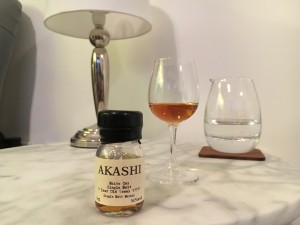 6th: White Oak Akashi Single Malt 5 Year Old (Sherry Cask #1373)
6th: White Oak Akashi Single Malt 5 Year Old (Sherry Cask #1373)
We are back in Hyōgo Prefecture today to revisit White Oak distillery. After spending a few days with the “established” players it is interesting to note that the aforementioned owner Eigashima Shuzo received their whisky distilling license back in 1919, 5 years prior to Yamazaki commencing production. It would seem that this would give Eigashima a legitimate claim to have produced the original Japanese whisky, but it is unclear what exactly was being distilled and sold prior to the much more recent move to the Akashi site in 1984.
What is known is that the new distillery contains dedicated facilities for whisky production separate from those used for the company’s core sake and shōchū products, and has been producing malt whisky since the early nineties. Initially whisky production was very limited at the distillery, only cranking up the stills for one month out of the year. Today this has increased to five months but until the additional stock matures there will inevitably be only a small number of releases under the Akashi label. In the UK the Akashi Blended, Meïsei blend and a NAS single malt are readily available, and are occasionally supplemented with targeted single cask releases.
Today’s whisky is one of these: a single cask expression that appears to have been bottled primarily for the German market. Sherry cask #1373 is a 5-year-old whisky which actually spent its first 3 years in ex-bourbon hogsheads before being transferred to an ex-sherry butt. Given the outturn of 960 bottles it is safe to assume that the butt was filled to capacity from more than a single hogshead. After spending its final 2 years in cask #1373 the whisky was bottled without artificial colouring or chill-filtration at 50% ABV.
Nose: A huge hit of sherry initially bringing rich dried fruit with lots of treacle and molasses sweetness. A faint savoury roasted meat aspect. Behind the sherry is sugar-sprinkled red fruit which gives a good sweet/tart balance. There are fruity-floral peach blossom notes which become more assertive in time, eventually being joined by some damp earthy/woody notes. A few drops of water really tempers the sweet side of the nose, leaving wax crayons with water.
Taste: A surprisingly rounded palate at 50% ABV, there is plenty of sherry dried fruit and brown sugar, lots of treacle toffee with some light smouldering char giving a nice savoury balance. Some toasted wood spice lightens things toward the finish.
Finish: Spice mingles with rich treacle in a pleasantly long finish.
A surprisingly complex sherry-bomb of a dram – quite unexpected considering the spirit spent less than half of its short life in ex-sherry. I have only seen such expeditious sherry influence from bota corta casks previously, although I can’t find any evidence that these are used at White Oak. Nevertheless, a cracking dram particularly if you are a fan of sherry bombs, although at £135 there is some stiff competition.
We complete the first week of advent with another whisky from that giant of Japanese whisky, Nikka. The diversity of whisky produced by Nikka is demonstrated by virtue of today’s expression being once again from a different category – a blended malt.
Blended malts are a product of 100% malt whisky (no grain unlike blended whisky) distilled in pot stills and from more than one distillery. Historically these whiskies were also known as vatted malt or pure malt and clearly the latter terminology is still in use in Japan. In Scotland however, the SWA updated their regulations back in 2009 to forbid these terms and settled on “blended malt” in an effort to eliminate any confusion – although this proved to be somewhat controversial as many felt that it would have the opposite effect. Fast forward the best part of a decade and the category remains rather niche although Nikka’s Pure Malt range is well-established.
From the colour-coded Pure Malts – also including a Black and previously a White – today’s whisky is Red. Going by Japanese colour connotations one might expect this dram to be rich and assertive were this the intention of the branding. A combination of malt from Yoichi and Miagikyo distilleries, Pure Malt Red is bottled at 43% ABV without statement on use of chill-filtration or colouring (so we will assume both are used).
Nose: Sweet notes of spiced fudge with toffee, ginger and cinnamon. The sweetness is balanced with some perfumed blackcurrant, and given some time we get pencil shavings and the scent of a carpenter’s workshop.
Taste: Toffee, butter dipped in sugar. There is a good hit of vanilla and other fresh wood notes alongside white chocolate. At 43% the palate has just enough alcohol to ensure an assertive delivery.
Finish: A short-to-medium finish with oaky spice becoming drier in time.
This is a pleasant enough straightforward dram, although for £5 less the From The Barrel is in my opinion a more exciting whisky.
Despite yesterday’s assertion of blended malts being a niche category there seem to be a few around in Japan at least, and today we find ourselves with another. This time we have once again moved away from the big players to sample some Mars whisky.
Mars is the name given to whisky produced by Hombo Shuzo, a producer of spirit since 1872. Originally focused on shōchū, a license to produce whisky was acquired in 1949 with distillation originally taking place in Kagoshima Distillery. In 1984 (which was apparently a popular year to move distillery in Japan!) whisky production was moved to the new Shinshu Distillery in Miyada, Nagano Prefecture. A stunning location in the Japanese alps in the shadow of Mount Komagatake (not to be confused with the mountain where Hakushu is located!), Shinshu sits just shy of 800 metres above sea level, making it Japan’s highest distillery. Given the different boiling temperatures at altitude this location no doubt has an influence on the spirit produced.
As difficult as it is to believe today, there was a distinct lack of demand for Japanese whisky back in the 1990s, which led to Shinshu falling silent between 1992 and 2012. Some older bottlings are still available (if you have rather deep pockets!) and today the younger spirit is being made available.
Today’s dram is quite interesting if you have been paying attention, in that it is a blended malt from a company who own just a single distillery. As we have established, Japanese distillers do not share their product meaning that Mars Maltage Cosmo must include whisky from elsewhere. And so Cosmo is a blend of malt from Shinshu distillery and several undisclosed Scotch malt whiskies. Bottled at a not-too-shabby 43% ABV this promises to be an interesting dram!
Nose: An initial wave of rich caramel subsides to reveal herbal notes of cut grass. There is a botanical feel with orange peel playing a lead role. In the background are light almonds and a faint floral aspect.
Taste: – Following what seems to have been a theme of Japanese whisky thusfar the palate is unexpectedly creamy. There is gentle vanilla fudge and some candied orange peel. No sign of the herbal aspects from the nose.
Finish: – A fairly short finish sees the vanilla transition to more oaky spice.
An interesting and promising nose which is let down somewhat by a fairly pedestrian palate. For £60 there is some fairly formidable competition.
There is something rather unexpected lurking behind the 9th door of the Japanese Whisky Advent calendar: Togouchi is a blend of malt and grain whisky from Scotland and Canada. Clearly regulations in Japan are more flexible than those from the SWA in Scotland; it seems that although Japanese whisky is defined as having been produced in Japan, production can be limited to the ageing and bottling phases with spirit originating elsewhere. To be fair to Togouchi they are not the only producer sourcing whisky from outside Japan – as we have seen on a couple of occasions during Advent so far – and they are quite open about the provenance of their whisky.
Chugoku Jozo are a producer of sake, shōchū and fruit liqueurs since 1918 who in 1990 decided to turn their hand to ageing and blending whisky. This was possibly a combination of tremendous foresight and a stroke of luck as this decision was made on the brink of a bleak period for Japanese whisky where demand was low and others were ceasing production. This meant Chugoku Jozo were rather well-placed when the market turned back in their favour.
More than just another blend of imported and naturalised whiskies, Togouchi is unique due to its maturation. Rather than storing casks in warehouses, Chugoku Jozo age their whisky in an abandoned tunnel in the village of Togouchi, Hiroshima Prefecture. Originally intended as part of a railway expansion linking Kabe and Hamada, the project was cancelled and the tunnel lay unused until Chugoku Jozo decided that with a stable climate of 14°c and 80% humidity year-round it would make the perfect location for maturing whisky.
Today’s whisky is the 9 year-old from the range. Matured in the tunnel in a combination of ex-sherry and brandy casks before being bottled at 40% ABV.
Nose: An initial balance of fruit and malt with red apples and grapes. Behind this is a sweet layer with sugary honey and some light fudge.
Taste: Estery and slightly perfumey initially, there is citrus peel with some red fruit. From the mid-palate things become rather sweet with vanilla fudge.
Finish: A fairly short finish sees rich baking spice mingle with damp forest floor notes.
Once again we have a very pleasant and drinkable whisky for which I would be happy to part with up to £50, but at today’s asking price of over £70 it unfortunately falls outside of the value band.
Hibiki is a name that likely needs little introduction to any seasoned whisky enthusiast. This blended whisky from Suntory in its distinctive bottle stands out on shelves (when it can be found these days) and has even featured in a Hollywood movie!
Hibiki is a blended whisky comprising malt from both Suntory malt distilleries Yamazaki and Hakushu, alongside whisky from Chita, the company’s grain distillery. The blend was first launched in 1989 to commemorate Suntory’s 90th anniversary and was initially available available as 17 year-old. Why 17? Chita opened back in 1972 so the original release would have had grain from the first spirit from the final component in the Suntory blend.
Suntory take great pride in the effort and level of detail that goes into every aspect of Hibiki. This is obvious from the smallest detail of the decanter bottle in which it is sold: the 24 facets on the bottle representing the traditional Japanese lunar calendar and symbolising the passage of time, the calligraphy on the handmade Echizen Washi paper and the use of the most noble colour purple. Of course it’s the whisky inside which is important, and a similar effort is taken here. Selected and blended by a team led by Master and Chief blenders Shingo Torii and Shinji Fukuyo (part of a very exclusive club having held these positions), Hibiki is blended from whiskies matured in five types of casks including ex-bourbon, ex-sherry and a Japanese plum liqueur, using different species of wood including the difficult-to-work-with Japanese Oak, Mizunara.
Today’s whisky is the newest in the Hibiki lineup, Japanese Harmony. Due to immense pressure on stock throughout Suntory’s portfolio, this No Age Statement blend has replaced the old 12 year-old as the entry-level offering in the Hibiki range. Bottled at a healthy 43% ABV, the intention was to create a “quintessential Hibiki” in harmony with the original ethos of the blend, working of course under the constraints of the younger stock available today.
Nose: Lots of rich juicy citrus notes of satsuma, some fresh cut grass and a light sweet floral aspect. Some smoke (from the Hakushu) is detectable at the back of the nose.
Taste: Bright and sweet initially with vanilla fudge and orange oil. Things become perfumed on the mid-palate with a light honey providing sweetness.
Finish: Nicely balanced between malt, citrus and oak spice.
A nicely balanced blend which serves as a great introduction to a fantastic range of whisky.
In further evidence of just how dominant the two large players in Japanese whisky are, we have another whisky from Nikka today. Far from being dull and repetitive, the whisky behind today’s door is once again somewhat unique and defies convention.
To recap, Nikka manages two distilleries: the exclusively malt-producing Yoichi and Miyagikyo, a distillery with both pot stills and Coffey stills and hence capable of distilling both malt and grain whisky. This configuration along with Nikka’s taste for the unconventional means that a wide range of palates are catered for despite the small number of production sites.
Today’s whisky makes use of all the stills Nikka has to hand; the pot stills at Yoichi and both the pots and column stills at Miyagikyo. So far this sounds like a regular blended whisky, but what makes All Malt a little different is that it uses malt whisky from the column stills (i.e. the Coffey Malt), hence the name! You may consider this a blended malt for this reason, but the SWA at least do not consider column-distilled spirit from any grain a malt whisky so by their definition this would be a blended whisky. The long arm of the SWA does not extend as far as Japan of course, and I am not sure if Japanese regulations have anything to say on this category.
Regardless of naming and categorisation the liquid inside the bottle is what is important, and today we have a blend of malt whiskies distilled by different means before being married and bottled at 40% ABV. There is not much information on maturation and the whisky is No Age Statement.
Nose: A balance of buttery sweetness and fresh notes: Buttermint sweets and Toffifee, vanilla and wood spice on the sweet side, cut grass and a faint mint note on the fresh side.
Taste: Creamy and buttery toffee pennies on the palate, the influence of the Coffey Malt is making its present felt on this dram. There are also Mint humbugs, and on the herbal side the slightest hint of marjoram.
Finish: The finish is all too short with cinnamon butter and pencil shavings.
At less than £40 this is good value, it’s a pleasant whisky to sip on its own but would be a good choice for a highball or a mizuwari.
Two days after the first exploration of Suntory’s Hibiki blend in the form of its newest expression, we are back today to delve into the original whisky in this flagship range: the much revered Hibiki 17.
Fairly easily obtainable in the recent past, the last couple of years have seen availability all but disappear – a trend which was exacerbated by Suntory’s discontinuation of the 12 and 30 year-old expressions – and on the rare occasion a bottle can be found at retail in my experience the asking price won’t be too different from what they exchange hands for at auction! With this in mind it is something of a treat to have the chance to sample this dram as part of my Advent adventure, let’s hope the whisky lives up to the reverence.
Blending is clearly taken seriously at Suntory; the current master blender Shingo Torii is only the third in the company’s history after both his father and his grandfather – founder and Japanese whisky legend Shinjiro Torii. Shingo oversees a team of blenders led by Shinji Fukuyo (only the fourth chief blender in Suntory history) who are described in marketing material as “highly trained artisan-scientists” dutifully sampling around 300 whiskies each day. Torii’s own views on blending as a science differ somewhat, relying on his – and his team’s – instincts.
Today’s whisky is a 17 year-old expression composed in the same manner as the rest of the Hibiki range, utilising whisky from both Suntory malt distilleries as well as Chita grain distillery, matured in a mixture of American and European oak alongside Mizunara before being bottled at 43% ABV.
Nose: An intense nose brings rich and perfumed fruit notes of plum and raspberry, lightly drizzled in Manuka honey. There is some oak polish alongside walnuts with some cinnamon in the distant background. Given some time milky coffee appears alongside an interesting incense-like note.
Taste: A beautifully silky mouthfeel brings a great balance of oak, citrus fruit and the rich dried fruit. Things become a little spicy on the midpalate with a little cinnamon and ginger before this is rounded out with the earthy spice of cocoa.
Finish: Satisfyingly long with the cocoa earthy spice from the back of the palate alongside hazelnuts.
An absolutely stunning dram that I could nose for hours – such a pity it has become so difficult to find (for a reasonable price)!
We kick off the second half of Advent with a transition from an esteemed blend from one of the Japanese whisky giants to one from the other. We have already encountered Nikka‘s clean, sweet and fruity Pure Malt Red, now we contrast this with the powerful, rich and firm Pure Malt Black.
Once again we have a whisky under the Nikka label which promises something different from the other whiskies in the range; even within the Pure Malt lineup there are contrasts and contradictions. In terms of branding we can draw a parallel with a certain Striding Man well-known in Scotch whisky: each whisky across the Johnnie Walker range is packaged in the same distinctive bottles with the coloured labels differentiating each expression. In Johnnie Walker’s case the colour largely separates blends at different price points and (perceived) quality, with the core character of the whisky being consistent across the range. For the Nikka Pure Malt series we see the opposite: the whiskies (well, those still in production) are offered for roughly the same price and cater to different palates.
An interesting strategy from Nikka, I would have imagined that having such different whisky across similar product lines would cause confusion to the average consumer (would the occasional drinker perusing a store shelf be aware of the difference between a Pure Malt and an All Malt, for example?).
To clear up any potential confusion, today we have a blended malt comprising whisky from Nikka’s Yoichi and Miagikyo distilleries, with the Yoichi malt taking front seat this time to provide those powerful, rich peaty notes. Bottled at 43% ABV, this blended malt is offered for a respectable £45 or so (albeit for a 50cl bottle).
Nose: A peat smoke which is initially quite coastal and briney with an underlying sweetness. Things don’t stay light for long before becoming rich with plenty of cocao and other earthy tones. Given some time a herbal aspect appears with a hint of fresh mint, with some buttery malt character in the background.
Taste: Plenty of earthy peat from the nose, some creamy-textured butter notes behind this with a touch of vanilla and wood spice. From the mid-palate things turn darker bringing dark chocolate with crystallised ginger which goes on to dominate the palate.
Finish: A medium-long finish with lingering richness of peat and cacao.
A gloriously rich and firm blended malt at an attractive price point – if you like Lagavulin you’ll probably enjoy this style.
Today we find ourselves in Aichi Prefecture for our first visit to Chita grain distillery in the eponymous town. Opened in 1972, Chita is Suntory’s grain distillery producing the “dashi broth” base of the Hibiki range of blended whisky. It was the Suntory vision to have the ability to produce a diverse range of whisky that led Keizo Saji – the second Master Blender – to build the distillery, completing Suntory’s ability to create its own blended whiskies.
Unlike most grain distilleries in Scotland which tend to use wheat these days for economic reasons, Chita primarily distills from a corn mash. Interestingly three different types of grain spirit are produced on-site, classified as heavy-type, medium-type and light-type for spirit that has been distilled through two, three or four columns.
With most of Chita’s output going into the Hibiki range as well as the Kakubin and Suntory Old blends there isn’t much spare capacity for single grain releases, but luckily Suntory have seen to produce a distillery-bottled expression which has been rolled out slowly over the last couple of years culminating in general availability in the UK earlier this year.
The Chita is a single grain whisky – presumably from a corn mash – which has been blended to a recipe originally created by distillery founder Keizo Saji incorporating light, medium and heavy-type spirits produced at the site. The whisky is matured in a combination of American oak ex-bourbon, European oak ex-sherry and ex-wine casks before being bottled at 43% ABV with no age statement.
Nose: Initially creamy and sweet, things then become slightly herbal with a resinous pine sap and a touch of thyme before moving to fresh wood spice and perfumed plum with a tiny hint of liquorice at the back.
Taste: A sweet and creamy palate brings sponge cake with fresh raspberries and cream; Eton mess. There is some floral honey on the mid-palate onwards.
Finish: A short-to-medium finish with lots of creamy toffee.
A pleasant light summer dram, this would no doubt work well in a highball.
We are back in Hiroshima Prefecture today to pay another visit to the disused railway tunnel in Togouchi. To recap, Togouchi is a product of Chugoku Jozo who are primarily producer of sake, shōchū and fruit liqueurs who have more recently moved into the whisky industry. Rather than build a distillery and produce their own spirit from the start, the company took the rather unusual step to source new make malt and grain spirit from Scotland and Canada, filling to cask before maturing in an abandoned railway tunnel that with a stable year-round temperature and humidity of 14°c and 80% provides ideal (according to the people at Chugoku Jozo anyway!) maturation conditions.
Chugoku Jozo seem to have been fairly open about the provenance of their spirit but regardless of that some Japanese whisky purists do not recognise Togouchi. With this in mind, in the few days since our last visit to Togouchi Chugoku Jozo have announced that they are moving into the distillation space with a new distillery Sakurao – production should be kicking off any day now. It remains to be seen if spirit from Sakurao will also be tunnel-matured or if there will be two product lines, but either way I’m sure the company will gain more legitimacy in the eyes of the purists in the years to come.
While we wait the few years before this new spirit becomes available we have a fairly wide range of whisky available under the Togouchi name: as well as a couple of No Age Statement expressions there are 9, 12, 15 and 18 year-old bottling available – plenty to hold a whisky lover’s attention.
Today Advent brings us the 12 year-old, a blend containing some peated malt and matured in a combination of ex-sherry and brandy casks in the tunnel before being bottled at 40% ABV. There is no word on the use of artificial colouring across the range but given the colour of the younger expressions it does not look like there was any added.
Nose: Fresh with cut grass in a summer meadow alongside a light fruit blossom. Some lemon peel is joined by a hint of dry smoke. Given some time things sweeten up with some set floral honey.
Taste: That classic Japanese creamy mouthfeel delivers a light non-phenolic smoke. The fresh cut grass from the nose is present alongside a touch of marzipan and almond macarons.
Finish: A reasonable-length finish brings vanilla fudge and wood spice.
In a similar theme to the 9 year-old, this is a pleasant drinkable whisky which is let down by an exorbitant £70 price tag.
We take a break from travelling today, and instead stay in the tunnel at Togouchi. By now we are quite familiar with this range of whisky from maturers-turned-distillers Chugoku Jozo, featuring whisky matured in a disused railway tunnel in the eponymous town in Hiroshima Prefecture.
As has been well covered, the tunnel was chosen as a site ideal for maturing whisky due to its year-round stable climate of 14°c and 80% humidity. So why exactly would this be considered the ideal conditions for whisky maturation? The answer is that this is a rather subjective assertion, and it gives an insight into the Japanese palate and hence Japanese whisky itself.
At a high level, maturation can be thought of as three distinct effects on the slumbering spirit: an additive effect where the spirit takes on various lactones from the wood, a reductive effect where compounds are broken down and/or lost from the spirit and an interaction effect where chemical reactions within the spirit affect its composition. Temperature and humidity have an effect on the rate of these processes, and importantly the fluctuation of these parameters have a large effect too: temperature changes in particular cause a cask to “breathe”, drawing in and letting out spirit from the porous oak in a process which accelerates the additive effect of maturation (i.e. cask character develops quicker).
With this basic understanding it would suggest that a stable climate would minimise additive maturation and allow the more subtle distillery character to take centre stage – a style which would appear to suit Japanese tastes given the vast majority of the whisky that has made up Advent thus far.
Today’s dram is the entry-level expression from the Togouchi range, the (ironically named for an entry-level) No Age Statement Premium. We can safely assume that this expression will contain whiskies younger than the 9 year-old sampled previously, and with the above in mind we should get a good insight into the Scottish and Canadian spirit in this whisky.
Nose: An undeniably young whisky which needs some time to settle in the glass. Initially spirity and lively with fresh grass, a distinct mineral note and a touch of charcoal. Given some time the whisky opens up a little, becoming softer with floral perfume and a little warm vanilla.
Taste: Light stone fruit and tangerines in syrup notes up front. A light honey appears on the mid palate, with the grassy/mineral notes from the nose beginning to dominate from then on.
Finish: A very short finish sees more fresh grass notes alongside a touch of vanilla.
An interesting whisky to sample and see the effect of a very slow maturation in its early stages, but at £40 I’m not sure I could find a space for a bottle.
 17th: Akashi White Oak Single Malt
17th: Akashi White Oak Single Malt
We return once again to Akashi, Hyōgo Prefecture to become acquainted with a core expression from White Oak distillery. Owned by Eigashima Shuzo – a company whose long history dating back to 1679 makes its lifelong family ownership all the more impressive – arguably the first Japanese distiller given its whisky-making license was granted back in 1919.
White Oak is the only Japanese distillery to sit on the coast; a more common trend is to set up in a mountainous region with the underground water source being a primary driver for the location (I imagine the logistics of transporting malt and spirit to and from the distillery makes the coast a much preferable location!). Despite the oft-repeated claim that a seaside location can lend a salty tang to the whisky, there is certainly none detectable in the Akashi range.
Today is a nice contrast to the tunnel-matured whisky from the previous two days; the warehouses used for maturation by White Oak are said to experience rather large swings in temperature between summer and winter, which should see accelerated cask influence in the ageing process.
Today’s whisky is a No Age Statement Single Malt release which is currently something of a core expression in western markets. Using lightly peated malt barley imported from Scotland, information on ageing is sketchy but is said to have involved a combination of ex-sherry, brandy, bourbon, wine and shōchū casks. Whilst I have no doubt that White Oak have matured whisky in all of these casks I am sceptical that this particular expression is blended from a combination of all of these. Despite the lack of an official age statement, the whisky is said to comprise 4, 5 and 7 year-old spirit.
Nose: An initially nutty sweetness of toasted almond then becomes fruitier with peaches wrapped in waxed paper. On the herbal/spicy side there is some wormwood, warm vanilla and a faint hint of dry wood smoke.
Taste: A rather drying palate brings fruit gummies alongside peaches in syrup. A touch of vanilla on the mid-palate moves things onto the more woody aspects of the whisky, with pencil shavings in particular.
Finish: A short drying finish sees light sandalwood and carpentry workshops.
A fairly unusual character on this whisky that while interesting to sample falls short of its asking price of around £65 for 500ml.
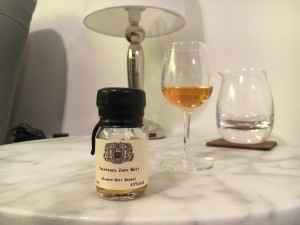 18th: Nikka Taketsuru Pure Malt
18th: Nikka Taketsuru Pure Malt
We return to one of another range of whiskies in the diverse Nikka portfolio today, the entry-level offering in the Taketsuru Pure Malt lineup.
This range of blended malt whisky is named after the godfather of Japanese whisky and founder of Nikka, Masataka Taketsuru. Born into a family of Sake brewers, Taketsuru was more interested in whisky and took the opportunity to move to Scotland in 1919 to study the art of whisky making. Taking an organic chemistry course at Glasgow University, Taketsuru simultaneously took on an apprenticeship at Longmorn distillery in Speyside before moving onto (the now long-closed) Bo’Ness distillery. In early 1920 he and his new wife moved to Campbeltown – which at the time was something of a whisky hub – where he continued his apprenticeship at (the also now-closed) Hazelburn distillery.
Armed with the new skills of distillation and blending in the Scottish style, Taketsuru returned to Japan in 1920 with a vision to create the first Japanese whisky in the same fashion yet taking on distinctly Japanese characteristics. Initially joining what would later become Suntory, Taketsuru achieved the goal of producing the first Japanese whisky but in order to fully realise his vision he left to form the company which would later be called Nikka. In 1934 Yoichi distillery was built at a location meticulously chosen for its similarities to Scotland. A full 35 years later this was joined by Miyagikyo distillery at a location specifically chosen by Taketsuru after he was fortunate enough to stumble upon another ideal whisky-making site.
The Taketsuru Pure Malt range honours the Nikka founder by blending whisky from both distilleries, with the lighter, fruity Miyagikyo making up the majority of the blend. The lineup consists of a 17 and 21 year-old as well as today’s No Age Statement expression. This expression was introduced in 2015 as part of a large supply-driven shake-up of the entire Nikka range, replacing the old 12 year-old. It would be interesting to discover if the whisky across the Taketsuru range follows a consistent character or if – like the Pure Malt colour series – each expression is independent. Given the limited availability (in the UK at least) of the 17 and 21 year-old it is unlikely I will make this discovery any time soon! Regardless, the entry-level NAS expression is a Miyagikyo-led blended malt with a significant ex-sherry matured component, bottled at 43% ABV.
Nose: Lots of forest fruit, primarily black plums and kirsch liqueur and damsons in the foreground. Behind this there is some earthy spice with coffee beans and dark chocolate.
Taste: Sherry maturation is more evident on the palate with plump dried fruit, but far from being overly-sherried this is a well-balanced whisky with plenty of the fruit from the nose – cherry liqueur in particular. The earthy spice from the nose is joined by some lighter warm vanilla, toasted wood spice and a tiny touch of char.
Finish: A pleasant finish sees rich, vibrant forest fruit linger.
A very pleasant and well-blended whisky – the sherry character is influential without being overly dominant – worth its £55 price tag!
With Advent into its final week there are a number of appreciable lessons we have learned in the course of our tour of Japanese whisky; primarily the ability of the big players in the industry to produce an impressively varied range of whisky from a small number of operations. This is of course due to the fundamental difference between the whisky industry in Japan versus that in Scotland (and most other countries): there is no sharing of resources between competitors. This single custom drives a lot of what makes Japanese whisky unique; it leads to setups like Suntory’s Yamazaki distillery where different washes with varied fermentation time in wooden/steel washbacks are then distilled in two of a number of very differently-shaped stills. From one site, many styles of malt whisky can be produced. Furthermore we have distilleries such as Miyagikyo where both pot and column-distilled malt and grain whisky are all produced under one roof.
Working within this industry practice and with this level of control, Japanese whisky producers have become remarkable blenders. With full oversight of the entire process from grain to cask selection, blenders at the Big Two can select and achieve very specific flavour profiles for a whisky brand. Nowhere is this more evident than at Nikka where there are no fewer than half a dozen separate and distinct ranges of blended whisky and blended malt.
The accuracy of the blenders has seen a number of blends being tailored very specifically to the Japanese palate: whisky that is very well-balanced with subtle characteristics; there are typically no sherry or peat bombs to be found in Japanese blended whisky.
This brings us neatly on to today’s whisky which may or may not offer something of a surprise. Another blended whisky produced by Nikka using malt from both Yoichi and Miyagikyo as well as grain from the latter, the simply-named Nikka Blended Whisky is a blend produced specifically for the international market. Have the blenders at Nikka turned their hands to catering to a Western palate, or is this intended as a gateway into Japanese whisky for the uninitiated? Bottled at 40% ABV without any statement on the use of chill-filtration or colouring.
Nose: Loaded with warm vanilla, light toffee and toasted wood spice. Behind this there is some dried fruit with sultanas and black cherry, alongside a rounded malty note. Given time the fruit becomes lighter and more citrus-led with orange oil.
Taste: That classic Japanese creamy mouthfeel delivers lots of toffee pennies and vanilla. The grain element makes its presence felt more on the mid-palate, lightening things up a little and brining eatery fruits: green apple and melon with citrus blossom.
Finish: A clean finish balances green fruit, malt and wood spice.
It is clear that this whisky is intended as a gateway into Japanese whisky, and it is testament to the skill of the blenders at Nikka that alongside classic Scotch blends, this expression punches well above its £35 price point.
As has been touched upon previously on our Advent journey, the great Nikka Shock of 2015 saw a massive overhaul of the entire range of Nikka whisky, dropping some whiskies entirely and replacing some with new expressions. Unsurprisingly given that this shake-up was driven primarily by pressure on existing stocks in warehouses at both of Nikka’s distilleries, the common theme across the revamp was the introduction of new No Age Statement expressions in place of old age-stated bottles. Across the entire range of single malt, blended malt and blended whisky offered by Nikka only a small number carry age statements today: the higher-end expressions in the Taketsuru Pure Malt series, and today’s blended whisky.
Today’s dram may come as a bit of a surprise as it was released as recently as 2014. Bottled to celebrate Nikka’s 80th anniversary, it went against the grain of the recent trend of NAS blends; with 12 Years Old proudly stated on the label, clearly this whisky is intended to serve the higher end of the market. This suspicion is further confirmed by the use of a capitalised determiner – it’s The Nikka – and of course the decanter bottle, shaped to resemble the overlapping layers of a Kimono and represent the layers of Nikka’s tradition (according to the marketing team anyway!). This whisky was initially offered to the Japanese market during Nikka’s anniversary year but has managed to make its way to the wider world in the years since and is now fairly easily obtainable in the UK (from the usual suspects).
As you would expect, this blend combines malt whisky from Miyagikyo (typically bringing fruit) and grain whisky from the Coffey stills on the same site (bringing butterscotch sweetness) with malt whisky from Yoichi (promising a touch of peat smoke). A fairly malt-heavy blend, this 12 year-old whisky is bottled at 43% ABV with no indication on the use of chill-filtration or colouring (therefore as always we will assume both are used).
Nose: Lots of sweetness from the Coffey grain: butterscotch sweets, notes of toasted coconut and milk chocolate balance with earthy spice. There is also fresh orchard fruit – apples and pears, some floral honey and a small touch of dry smoke providing balance at the back-end of the nose. Given some time the nose settles down into lighter fruits balanced with malt.
Taste: The palate initially has more bright wood spice than the nose would suggest, with vanilla and cinnamon joining the sweet caramel from the grain. Behind this is light citrus and floral perfume, with the faintest hint of smoke present on the mid palate.
Finish: A pleasantly-long finish brings coconut and tinned fruit.
This is the sort of whisky it pays to spend some time with; it is constantly evolving in the glass betraying its maturity and rewarding the patiently curious. A cracking armchair sipper which just about merits its £95 price tag.
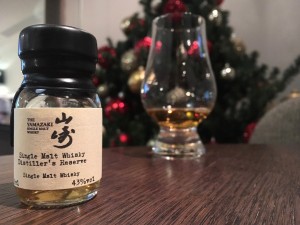 21st: Yamazaki Distiller’s Reserve
21st: Yamazaki Distiller’s Reserve
Today sees the first single malt whisky for a few days, and only the fourth of Advent so far. This gives some insight into the ongoing trend in Japanese whisky and the current focus for producers given the pressure on inventory across the board. We’re back with a Suntory whisky which is perhaps unsurprising; Suntory have a greater focus on single malts than Nikka, and nowhere close to the range of Nikka’s blended product lines.
Today’s Advent dram is from Yamazaki, arguably the birthplace of Japanese whisky given its status as the country’s first distillery. Built in 1923, it dates from the days of Masataka Taketsuru at Suntory, however unlike the Nikka distilleries the location of Yamazaki was not chosen by him. Instead, Suntory founder Shinjiro Torii wanted a distillery with uniquely Japanese character and thus Yamazaki was built in Shimamoto, Osaka Prefecture – an area with a wide range of temperature and humidity year-round creating fast maturation conditions known by some as “Suntory Maturation”. This location also ticked a box of great importance to Japanese brewers and distillers in having access to a good quality water source. “Rikyu no Mizu” or Water of the Imperial Villa is one of the purest mineral waters in Japan, and was the reason Sen no Rikyū (chief influencer of The Way of Tea) also called the place home – high validation indeed!
The entry level whisky in the Yamazaki lineup, the No Age Statement Distiller’s Reserve was first introduced in 2014 to ease pressure on the younger age-stated Yamazakis. The Distiller’s Reserve features young talent whiskies of just 3 years old matured in ex-red wine casks, some older malts matured for approximately 20 years in ex-sherry casks, and a portion of whisky aged for 12 years or so in Mizunara (Japanese oak). Bottled at 43% ABV, presumably with colouring and having gone through chill-filtration.
Nose: The ex-red wine “young talent” takes centre stage bringing ripe strawberries and other fresh summer berries, becoming richer in time with the addition of vanilla: strawberry bon-bons and black cherries. In the background is a hint of desiccated coconut and a real fragrant resinous oak quality which balances out the sweetness nicely.
Taste: An initial burst of orange blossom and white peach settles into a fresh and slightly herbal/spicy palate. Not as sweet and fruity as the nose suggests, until the strawberry and vanilla begins to dominate on the mid palate. A perfumed note of parma violet. There is a slightly astringent quality throughout which serves to provide balance.
Finish: A quickly drying finish sees a balance of red fruit and pine needles. A touch of white pepper heat betrays some of the younger spirit in this whisky.
There is a lot going on in this whisky with every aspect done in a very thoughtful, deliberate manner. A showcase in Japanese blending and a good example of how NAS whisky should be done.
Today’s whisky has had a significant bearing on the character of a number of the whiskies sampled during Advent; the grain whisky produced at Miyagikyo distillery is the core component of a number of Nikka’s blended whisky products including From The Barrel, Blended Whisky and The Nikka 12. After this showcase on how grain whisky can lift and support a blend, we now have the chance to discover how the spirit stands on its own.
Nikka’s grain whisky is produced at Miyagikyo distillery, a facility fairly unusual in that both malt and grain whisky are distilled on the same site. As well as eight familiar-looking pot stills, two rather large Coffey stills (also known as continuous, column or patent stills) are also now part of the distillery after having been built and shipped over to Japan by Glasgow company Blair’s Ltd in 1963. The eagle-eyed reader may have spotted that this was 6 years before Miyagikyo was built – distillation in the Coffey stills actually took place at Nikka’s Nishinomiya plant until as late as 1999 when they were moved to their current location. Today Nishinomiya plays no part in Nikka’s whisky production, having been converted into a brewery for Asahi. Eighteen years after the move, it is safe to say that the vast majority of the whisky in today’s bottle will have been distilled at Miyagikyo.
Although – as we have seen – these stills can be used to produce malt whisky, their principal function is distillation of a grain-based spirit. At Miyagikyo, grain whisky is distilled primarily from corn with some malt barley in the mash to aid fermentation. For this reason it is occasionally referred to as Japanese bourbon, but although there is not much information regarding the casks used to mature this whisky it is safe to say that unlike a bourbon there were no new barrels involved.
Nikka first tested the grain whisky waters with a few (rather limited) single cask releases that were difficult to get hold of outside Japan, but thankfully due to their success a standardised expression became part of Nikka’s permanent lineup around five years ago. This core release is bottled at 45% ABV without an age statement.
Nose: Lots of sweet vanilla notes alongside buttered popcorn, icing sugar-dusted toffee bon-bons and chocolate caramels. There is some cereal, dry grass and a touch of toasted coco and other earthy spice. A young spirit-y note right at the back of the nose gives away some of the more youthful grain.
Taste: Consistent with the nose there are toffee pennies and vanilla, toasted coconut and milk chocolate. Things become more fruity from the mid palate onwards with tinned fruit in syrup and a balancing note of grapefruit peel.
Finish: A continuation of the back of the palate brings grapefruit peel with some toffee before drying out rather quickly.
This is an interesting dram offering something a little different from the usual younger grain whiskies. Perhaps not an every day drinker, it is easy to see why this is a favourite among bartenders as a cocktail base.
The penultimate day of Advent sees us travel back to familiar territory: to Hiroshima Prefecture and the village of Togouchi, where whisky is aged and blended by Chugoku Jozo in a tunnel.
We have explored most dark corners of the tunnel, having uncovered the NAS Premium, a 9 year-old and a 12 year-old expression in the course of advent thus far. To recap, Togouchi whisky is a blend of malt whisky from Scotland and grain whisky from Canada which has been “naturalised” in Japan before being taken into a disused railway tunnel near the eponymous town for aging. Chugoku Jozo were until very recently not whisky distillers – hence importing spirit – but during Advent there was the exciting news of a new distillery opening: look out for Sakurao in the future! Although new to distilling Chugoku Jozo have many years experience of cask selection and blending; the unique location of the railway tunnel was chosen as a maturation location due to its stable climate of 14°c and 80% humidity, hailed as an ideal environment for whisky maturation. The reason for this assertion is likely that the stable temperature encourages a very slow additive effect in the maturation; i.e. a whisky which retains plenty of spirit character for extended ageing periods.
Today we get to see the effect of a longer maturation period in this environment with the 15 Year Old expression. Whereas younger whiskies in the Togouchi range led with lighter grassy, orchard fruit notes, perhaps the additional years in the tunnel will start to see these balanced with some of the richer notes that the combination of ex-sherry and brandy casks can offer. Unlike the younger offerings from Togouchi, today’s whisky is bottled at a higher 43.8% ABV which should hopefully allow its full character to shine through.
Nose: Takes a few seconds to calm down in the glass, starting off with peppered strawberries before moving on to dried cranberries and a floral honey. Given some time things become richer with vanilla ice cream with strawberry syrup, sprinkled with powdered cinnamon and nutmeg.
Taste: A big initial hit of malty sweetness is joined by milk chocolate to give maltesers. There is also sweet nutty notes of marzipan and a fresh floral note in the background.
Finish: Alongside notes of warm spice, a touch of black pepper on the finish takes us back to where this dram began.
This whisky did not feel particularly well-integrated which is surprising given its longer, gentle maturation. There were a few sharp edges, which unfortunately makes its £175 price tag all the more inordinate.
We have come to the end of our Japanese whisky Advent, and the end of the journey takes us back to the beginning of the Japanese whisky story and to Japan’s oldest distillery. Suntory’s Yamazaki distillery in Shimamoto, Osaka Prefecture was the first whisky distillery built in the country and is held in rather high esteem in Japanese whisky circles to this day.
Despite being built back in 1923, the release of the first Yamazaki single malt – a 12 year-old – did not occur until 1984, with all of the output in the period between directed into blended whisky. A couple of years later the distillery was overhauled with a whole host of new equipment including wooden washbacks as well as stainless steel, and both direct-fired and indirect-heated stills. This pursuit of diversity has continued to the current day, with the recent addition of four more stills in 2013 bringing the total number of stills on the site to twelve, with three distinct still shapes. This flexibility in the distillation process is very much in keeping with the psyche of the Japanese whisky industry as a whole: the best use is made of modest space and facilities to produce any style of whisky that may be required. This is of course a particularly important trait when all of your blending takes place in-house.
Today’s whisky is the multi-award-winning and hugely respected 18 Year Old, a whisky which – despite the existence of a seldom-available 25 year-old – is arguably the jewel in the crown of not only Yamazaki but the entire core range of Suntory-produced single malts. As an example of the recent rise of Japanese whisky, I remember this as the first bottle of Japanese malt I ever purchased, effortlessly selecting the bottle with its distinctive black and gold label from a well-stocked shelf for a reasonable £70. This was around 7 years ago. Today it would be most unusual to find this whisky on a shelf at all, and when one does find a bottle for sale outside of auction the offer price will likely be in the same region as an auction lot regardless – up to £400!
The 18 Year Old is selected from stock including around 80% from ex-sherry European oak, 10% ex-bourbon American oak, and 10% from fabled Mizunara (Japanese oak). Bottled at 43% ABV, there is no information on the label regarding colouring or chill-filtration.
Nose: Lots of rich dried fruit balanced with juicy stone fruit. Plums, rich but not overly-cloying. A sweet incense smoke lingers in the background providing fantastic balance to the nose. Given some time more red berries appear alongside a slightly herbal note with some light mint.
Taste: Rather spicy on the initial delivery with cinnamon and light ginger being joined by a creamy vanilla toffee. After this, a wave of red fruit appears alongside some floral manuka honey. On the mid palate there is the faintest hint of liquorice and other root spice.
Finish: A subtle-yet-long-lasting finish sees red plum, spice and incense in equilibrium.
A fantastically balanced, assertive yet tender dram, and a fantastic example of Japanese whisky reaching its potential. Having said that, the demand and cult-like status surrounding Yamazaki at the moment has unfortunately rendered this whisky unobtainable at its reasonable value.
